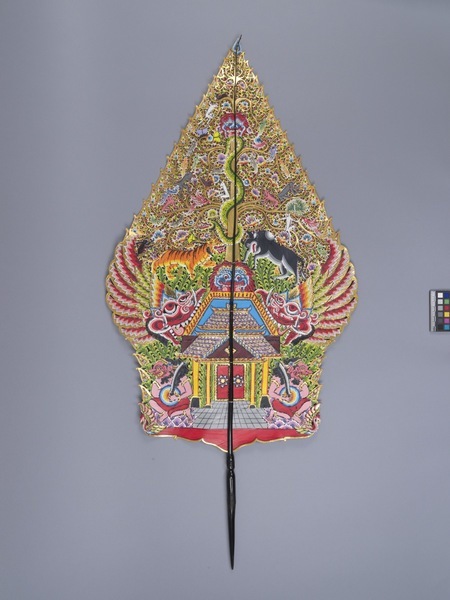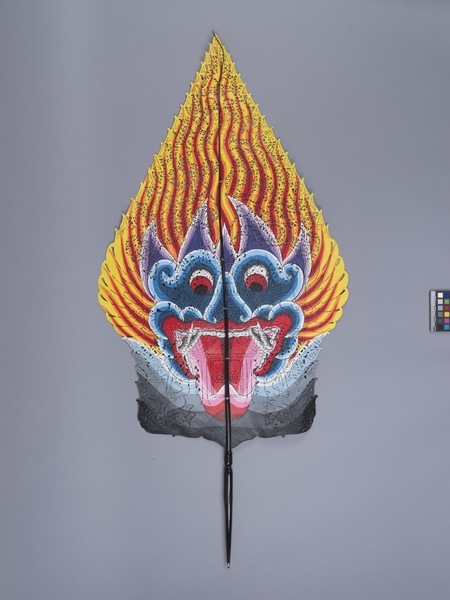Shadow Puppet Item Number: 3340/5 from the MOA: University of British Columbia


Description
Gunungan (mountain) or kayon (tree of life) wayang kulit (shadow puppet) from Ramayana series. Flat shadow puppet cut from hide. Spade-shaped. Side one: a gold tree extending up to the point. The tree branches are filled with monkeys of various colours, peacock feathers, and birds. A large snake is wrapped around the trunk, and at the base a bull and tiger face one another. The lower section depicts a covered entrance gate with ornate roof and yellow pillars. Large Garuda(?) heads with ornate crowns flank both sides, and two crouched figure of the twin giants Cingkara bala(?) and bala Upata(?) with shields and swords. Side two: A background of fire, with bright yellow, orange and red flames extending up to the point. A large depiction of Garuda's blue face with large open mouth, fangs exposed and tongue extended, and five shorter spikes of purples extending up from the brow. The lower section has five shades from white to black. Operated by one central horn rod.
History Of Use
Wayang kulit shadow play is over 1000 years old. It is thought to be derived from the leather shadow puppetry traditions of southern India, like tholu bommalata, which came to Java with the spread of Hinduism in the first millennium. In Java - part of the largely Islamic Republic of Indonesia - this highly distinctive form of shadow puppetry is valued as a pusaka, a sacred treasure of the royal court of Yogyakarta. They are inspired by the Indian epics, the Ramayana and the Mahabharata, as well as stories of the history and folklore of Java, with a local spin. The plays are performed to mark special occasions such as birthdays, marriages, and religious events. Wayang shadow puppetry was inscribed on UNESCO's List of the Intangible Cultural Heritage of Humanity in 2008. (from Shadow, Strings & Other Things, 2019)
Item History
- Made by Sugeng (Maker) in Yogyakarta, Java, Indonesia during 2008
- Owned by Sutrisno Hartana before January 28, 2019
- Received from Sutrisno Hartana (Seller) and Museum of Anthropology Exhibitions Budget (Funding source) on January 28, 2019
What
- Name
- Shadow Puppet
- Identification Number
- 3340/5
- Type of Item
- puppet
- Material
- water buffalo skin, water buffalo horn, paint and cotton fibre
- Overall
- height 107.5 cm, width 50.0 cm, depth 2.0 cm
Who
- Culture
- Javanese
- Creator
- Sugeng (Maker)
- Previous Owner
- Sutrisno Hartana
- Received from
- Sutrisno Hartana (Seller) and Museum of Anthropology Exhibitions Budget (Funding source)
Where
- Holding Institution
- MOA: University of British Columbia
- Made in
- Yogyakarta, Java, Indonesia
When
- Creation Date
- during 2008
- Ownership Date
- before January 28, 2019
- Acquisition Date
- on January 28, 2019
Other
- Condition
- good
- Accession Number
- 3340/0005